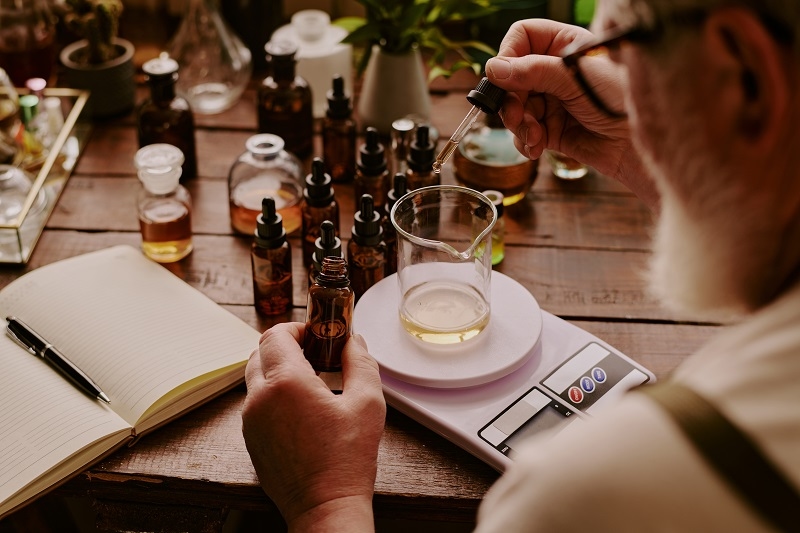
You're not just smelling one thing when you take in a scent. You're hit by a mix of smells put together to craft a unique and lasting smell. This mix rests on what scent makers call "accords." To get the art of making scents, it helps to learn about these accords simply for all who love smells. Once you grasp what they are and how they blend, your way of feeling scents will shift.
This guide will show you fragrance accords explained, how they come to be, the kinds you might find, and why they're key in making a scent from scratch. If you're keen on the usual scent accords or need a guide on how to mix scents, this will help you see it.
A scent accord is a mix of two or more scent notes that blend so well they make a whole new scent. It’s like how blue and yellow make green: you can't split the colors; you just get a new smell.
Scent makers use accords as the base for scents, adding them layer by layer to form a full scent. This is why a scent can seem rich and deep without being too much: each accord is in balance.
A single accord could copy a known smell, like fresh roses, smooth vanilla, or sea air. At times, accord aims to stir a mood rather than copy a real smell – like warmth, freshness, or mystery.
Without accords, a scent would be a mix of raw bits with no tune. The real skill comes when certain smell notes meet in just the right way.
Accords are vital because they:
Knowing about scent accords also lets scent lovers spot why a smell seems familiar or why two scents might seem similar: they might share an accord.
Part of what makes scent-making cool is how scents lie in layers to add depth. A perfume isn’t just a simple smell: it unfolds in three parts:
Scent makers craft special accords for each layer so that as they fade, new ones come up smoothly.
Knowing the usual scent accords can help you spot trends in smells you like. Here are some you’ll see often:
Each of these accords starts with single scent notes, finely tuned to create one smooth smell.
If you've ever wanted to make your own scent, an easy guide on mixing perfumes can help you start. The trick is to mix accords, not just random notes.
Choose the heart of your scent. Do you want it to smell like flowers, wood, citrus, or something sweet? This will shape the notes you pick.
Put in accords that go well with the main smell. For example, a flower smell can get richer with a wood smell or more bright with a citrus one.
Notes like musk, amber, or vanilla help hold down your perfume and let it last longer.
Mix in small bits, let it sit for a few days, and see how it changes.
By doing these steps, you'll learn how smells mix in a way that feels expert.

Perfumers think in accords since they use perfume blocks, not just plain notes. A block could be:
These blocks help make a smell that is even and fits well. For example, a "beachy" block might mix coconut, pineapple, and vanilla for a holiday feel.
Making an accord is both science and craft. Perfumers try various amounts, adjust how strong each note is, and see how they work together on skin. Even a small change can make the perfume feel different.
It's also about what we remember and feel. Many accords try to bring out certain feelings—like fresh grass for going back in time, smoky wood for warmth, or citrus for energy.
Once you know the accords, you can find them in perfumes you have or test in shops.
This helps you get good at seeing patterns. You might find many smells you like have the same flower-wood mix or citrus-musk combo.
Ever noticed how two different scents remind you of each other? Often, it's because they use similar key accords. Like many summer scents have the same citrus-sea mix, or winter ones use sweet or spicy-wood smells.
Perfumers sometimes start with classic recipes, changing them to make something new but still keeping that known base. That's why knowing common accords is useful—you can guess which perfumes you might like without smelling them first.
Old perfumes often have more complex and layered accords, developing slowly. They might have many different accounts working together.
New perfumes, like those from designers, might just focus on a few strong accords for a clear and strong feel. This makes them easier to like, but sometimes less detailed.
Using what you know about accords can make shopping for perfume easier. Here’s how:
This way, you pick based on the perfume blocks, not just the first smell.
Not all parts of an accord come from nature. Many use man-made stuff that copy natural smells or make new ones not found in nature. This lets perfumers be more original and careful with rare natural stuff.
For instance, a sea scent might use fake notes to copy sea air—hard to get from nature.
Some accords will last longer than others. Wood, amber, and musk scents may linger on clothing for hours, while citrus scents typically dissipate very quickly. This is why perfumers take care to balance the top notes which dissipate quickly with long-lasting base notes.
Understanding how these scents dissipate helps you to understand the sense of change in your perfume as you experience it.
Accords, or combinations of scents that create depth, balance and character, are the way scent is created. Understanding how accords work is the starting point to understand why some scents mean something to you, evolve, and some scents even have cult followings.
Understanding accords by learning new accords and creating guides for layering and mixing scents, as well as scent blocks in some of your favorite scents will enrich your experience and enjoyment of perfume. Whether you are wearing scents for pleasure or are actually creating a scent, understanding accords will enhance every experience.
This content was created by AI